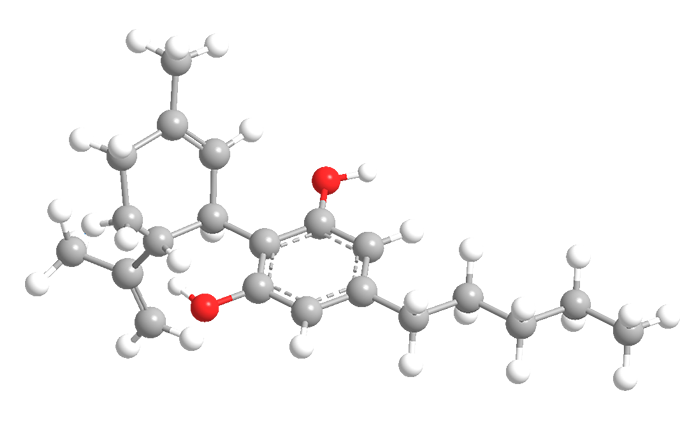What molecule am I?


Everyone knows (or should know) that (−)-trans-Δ9-tetrahydrocannabinol (THC) and many of its cannabinoid isomers are the chief psychoactive components of marijuana (Cannabis sativa). But some THC isomers are not psychoactive and may have some beneficial uses.
Members of the cannabidiol family fall into this category. The structure shown is the one typically used for cannabidiol; it goes by many names, including (–)-cannabidiol, Δ1(2)-trans-cannabidiol, and cannabidiol (7CI). There are at least seven known cannabidiol isomers.
In 1940, the iconic organic chemist Roger Adams and colleagues isolated cannabidiol as its bis(3,5-dinitrobenzoate) ester from C. sativa, which they called “Minnesota wild hemp”. At the time, cannabidiol’s isomerism was not recognized. It was not until the 1960s that its isomers’ absolute configurations were determined and some of them were synthesized.
Israeli scientists led by Raphael Mechoulam discovered in 1970 that cannabidiol and most other cannabinoids are not psychoactive. Since then, cannabidiol has been investigated for medical uses, including treatment for a virulent form of epilepsy. It is a component of some dietary supplements and cosmetics. Biologists are working on developing marijuana strains that suppress THC content and enhance the production of cannabidiol.
Cannabidiol’s regulatory status varies from one jurisdiction to another. The regulations are so irregular that in 2016 the European Industrial Hemp Association issued a position paper that suggested a regulatory protocol with the objective that all European Union countries would operate under the same rules.
MOTW update
The cyclopentazole anion was the Molecule of the Week for December 12, 2016. Its sodium salt was the first stable N5compound ever synthesized. But this salt is stable only in aqueous solution. More recently, Chong Zhang, Chengguo Sun, and coauthors in China prepared a stable (but complex) crystalline cyclopentazolate salt: (N5)6(H3O)3(NH4)4Cl.
MOTW update: July 9, 2018
Cannabidiol (CBD) is the term for a family of cannabinoids that are isomers of THC, the chief psychoactive component of marijuana. These compounds are not psychoactive, but they are useful for controlling pain and other medical conditions. Up to now, CBD had an unclear regulatory status; but it now has its first approval from the US Food and Drug Administration. On June 25, FDA approved an oral solution of CBD for treating seizures from two severe forms of epilepsy.
MOTW update: May 27, 2024
Cannabidiol1 (CBD) is frequently used for pain relief, and in 2018 the US Food and Drug Administration approved it for treating epileptic seizures. Recent studies showed that CBD can attenuate heart injury caused by perfluorooctanesulfonic acid (PFOS) exposure and can inhibit the proliferation of prostate cancer cells.
Although CBD has FDA approval for treating seizures, its mechanism of action was unknown until this month, when Pedro Martín and co-workers at the National University of La Plata (Argentina) reported how it works. In a rat study, the researchers found that CBD inhibits the BK channel1, which plays a role in the neuronal action potential’s repolarization.
1. BK stands for “big potassium”; short for the large-conductance voltage-gated and calcium-operated potassium channel.
MOTW update:
September 25, 2023
Cannabidiol1 (CBD) is a non-psychoactive cannabinoid from marijuana that is used for pain relief and has been approved by the US Food and Drug Administration for treating seizures caused by epilepsy and other conditions.
Earlier this month, Antoinette S. Perry and co-workers at University College Dublin reported that cannabidiol inhibits the proliferation and invasiveness of prostate cancer cells. In an in vitro study, the researchers observed that CBD inhibited cell viability and proliferation, accompanied by reduced expression of key cell-cycle proteins and inhibition of phosphorylation of the protein kinase AKT.
1. CAS Reg. No. 13956-29-1.
MOTW update:
April 17, 2023
Cannabidiol1 (CBD) is a non-psychoactive marijuana constituent that is useful for controlling pain and other medical conditions. Perfluorooctanesulfonic acid2 (PFOS) was the Molecule of the Week for January 28, 2019. It was once a widely used surfactant; but because it became an environmental pollutant—even appearing in human blood—it was removed from the market.
What’s the connection between CBD and PFOS? Earlier this month, Hang Yin, Shu Li, and co-workers at Northeast Agricultural University (Harbin, China) reported that administering CBD can attenuate PFOS-induced heart injury. In a mouse study, the researchers found that CBD alleviates myocardial cell apoptosis caused by PFOS by restoring antioxidant capacity, mitochondrial function, and energy metabolic homeostasis to the cells.
1. CAS Reg. No. 13956-29-1.
2. CAS Reg. No. 1763-23-1.

Learn more about this molecule from CAS, the most authoritative and comprehensive source for chemical information.
Molecule of the Week needs your suggestions!
If your favorite molecule is not in our archive, please send us a message. The molecule can be notable for its current or historical importance or for any quirky reason. Thank you!
Stay Ahead of the Chemistry Curve
Learn how ACS can help you stay ahead in the world of chemistry.

